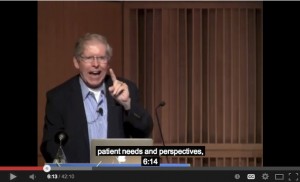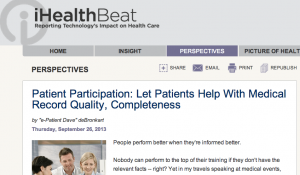 I’m at the gigantic HIMSS health IT conference in Orlando, in the consumer pre-conference. In my opening talk I briefly mentioned something I’ve said for years:
I’m at the gigantic HIMSS health IT conference in Orlando, in the consumer pre-conference. In my opening talk I briefly mentioned something I’ve said for years:
Have you looked in your chart? Your medical record? Do you know for a fact that there are no errors in it?
Most audiences appear intrigued and thoughtful at this. But ha ha ha, at HIMSS (people who work in health IT), on Twitter there are two interesting reactions:
- Several different people tweeted it, showing unusual interest in it, and more than a dozen retweeted those
- And, a whole bunch of people are saying “Who says?? What’s the source??”
How fascinating. Well, here’s what I know about it.
- 18 months ago I spoke at the Veterans eHealth University, a virtual university for people who work in the VA (veterans’ administration) health system. They asked me to submit some interactive audience response questions.
- One was to ask the audience if they had checked their own record. The results are in the slide above. (Sorry about the typos – that’s how the A/V guys typed it into the computer.) Results:
- 50 / 66 (76%) said no, they’d never looked. (Have you?)
- Of the 16 who had looked:
- 5 (31%) weren’t sure whether there were errors.
- Of the 11 who were sure:
- 7 found mistakes (64%)
- 4 found the record was perfect (36%)
So, roughly: of those who had checked, about 2/3 found mistakes: missing allergies, wrong medications, wrong diagnoses, etc.
Since then, depending on the audience, I’ve asked this of other audiences. Every time of those who’ve checked, about 2/3 found errors. Every time.
This is not a peer reviewed journal article. I’d love to see one! I also encourage all health IT speakers to ask their own audiences. Maybe mine aren’t typical, somehow.
And by the way – if you’re skeptical, do you know if your record contains everything doctors and nurses should know about you, and doesn’t contain errors?
As always, discussion is welcome!
It’s like the old Capital One commercials – do you know “What’s in your wallet?”
——————-
Updates added later:
- At the British Columbia Patient Safety & Quality Council conference later that week, in a post-keynote workshop, I asked the room about this:
- Of more than 100 in the room, eight had examined their entire records.
- Of those, six had looked errors, and two had found them completely accurate.


 Last month
Last month 

